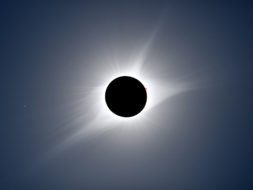The 2017 solar eclipse could easily be the most watched event in US history. Can we learn something from it?

Credit: Rick Fienberg / TravelQuest International
Up to 88% of American adults might have watched the total solar eclipse last August, doubling the number of viewers of the last Superbowl and tripling the audience of the Trump-Clinton presidential debate.
That’s the conclusion of a preliminary report on public viewing of the 2017 eclipse, the University of Michigan has announced.
According to the report, a total of 154 million American adults — 62.8% of all adults age 18 or older — viewed the eclipse directly. An additional 61 million adults who did not see the eclipse directly watched it electronically on a television, computer, tablet or phone screen. Up to 20 million Americans travelled to other locations to view the eclipse.
The results are based on an online and telephone survey of 2,211 adults who first answered a questionnaire between February and March this year, and then responded to a follow-up survey shortly after the eclipse.
This report’s outcome roughly agrees with CNN’s pre-eclipse poll, which found that 60% of Americans had plans to watch the eclipse. On eclipse day some internet services such as Netflix even said they noticed a sharp decline in user activity during eclipse hours — it’s a shame they didn’t create a map to help us visualize that data!
This is the first total solar eclipse to cross the continental United States from coast to coast in nearly a century. The advent of mass media and the internet no doubt increased awareness and preparedness for the astronomical show. "This level of public interest and engagement with a science-oriented event is unparalleled," said Jon Miller (University of Michigan), author of the report in a statement.
A third of adults reported taking pictures and video of the event, and about one in five also reported posting pictures or commentaries on social media.
The report also shows some curious results, such as that 74% of Americans used special solar glasses to observe the eclipse, but that figure goes up to 83% for those who traveled — perhaps because those traveling brought glasses with them.
According to the report, most adults who viewed the eclipse described it as an educational and enjoyable experience. Asked to describe their experience on a 0-to-10 scale, the answers averaged a 7.6 for being enjoyable and 7.0 for being educational. However, when asked if they actually learned something about the Sun and the solar system from watching the eclipse, the average answer dropped to 4.9 on the same scale. It went further down to 4.5 for actively seeking more information about it in the future.
It’s also worth mentioning that most people reported watching the eclipse with friends, family or co-workers, whereas a mere 3% was part of an educational organized group.
Some Shadows Remain
According to Miller and the University of Michigan, this is just a preliminary review of the information they’ve gathered so far. But as is, the report raises some questions. (The author hasn’t responded to a request for comment from S&T.)
First and most importantly, the survey didn’t discriminate between seeing a total or partial eclipse — a radically distinct experience for the viewers. It uses the expression “degree of totality” to describe the percentage of Sun’s surface covered by the Moon from a specific location, affirming that “surprisingly, adults who live in areas of higher totality were more likely to reporting traveling to another area to improve their viewing experience.”
“It’s not surprising if you know something about solar eclipses,” says Mike Simmons, president of Astronomers Without Borders, a California-based organization for astronomy education. “Watching anything less than totality is just varying degrees of a partial eclipse.”
Failing to recognize that fact, the report gathered information about people who traveled to see the eclipse, but it didn’t distinguish whether they traveled to the path of totality or if they traveled for other reasons. Such information would have been useful to future education strategies, Simmons says. Educational organizations put great efforts into convincing people that traveling to see totality would be worth it. They surely would have liked to see how successful they were.
The report also falls short in discriminating among the 61 million people who watched the eclipse electronically. Did they actively seek out a live stream of the eclipse while it was happening, or did they just happen to catch a glimpse during the news? Or, did they briefly scroll through a video that somebody else had posted on social media? The survey as presented doesn’t answer these questions.
Finally, responses are presented as averages in the preliminary report, which is standard practice; however, showing the whole spectrum of answers might reveal a polarized response among viewers.
A final report will be released in January 2018, which will include a follow-up survey on whether people who viewed the eclipse sought additional information afterwards, or whether they engaged in educational activities about the solar system and astronomy. Our hope is that when the final report comes out, it will provide more details for us to chew on.
 0
0









Comments
You must be logged in to post a comment.